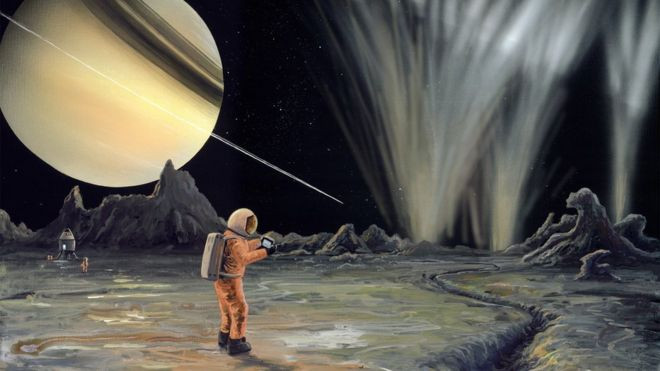Life may exist on Saturn's moon
The Cassini probe captures images of huge steam currents and other matter spewing out from the southernmost cracks of the moon Enceladus, making it one of the most likely places where extraterrestrial life exists. .
According to the BBC, Enceladus is Saturn's sixth largest moon. Vapor waves may have sprung up from a depth of 30 to 40 km from the southernmost point of Enceladus. Devices from the Cassini vessel after analyzing gas samples show that it is important that the chemicals in the underground ocean here are suitable for growth microorganisms. There are strong signs that water is interacting with rocks in the ocean floor to create nutrients for simple insects.

Simulating steam flow on the moon Enceladus.(Graphic: SPL).
"I have been interested in finding life in the solar system for decades and still amazed at what was seen on Enceladus. It is a small world away from us, rich in substance. organic and water and signs of life. It's amazing, " said Chris McKay, cosmologist, NASA's Aerospace Agency (NASA).
However, Cassini's technology from the 1980s and the 1990s was old, unable to prove the existence of microorganisms under Enceladus' ice. We will need to include many different satellites equipped with special sensors.
Next week Cassini will fly over Enceladus for the last time to capture a series of detailed surface images of this moon, ending Enceladus' exploration mission. NASA has opened a new spacecraft design competition for future Enceladus missions.
One of the designs is Jonathan Lunine, an interdisciplinary scientist, in charge of Cassini's mission at Cornell University, New York. He came up with the idea of a spacecraft called an ELF . This ship will be more compact than Cassini, bringing specialized instruments for analyzing bio-chemical components in the steam currents on Saturn's moon.
"With powerful mass spectrometers, we can detect amino acids and identify them," he said. "We can also detect fatty acids and isoprenoid in bacterial cell membranes, substances also in ancient bacterial cells, bacteria that survive in the harshest conditions of the Earth. We can also count the carbon content of these substances to see if they have the form of life, and we can finally measure the ratio of isotopes of carbon, oxygen and nitrogen to the body. determining the similarity with the Earth The organisms on Earth often have lighter isotopes when metabolizing these substances in the system ".
However, this design idea was not selected. One of its problems is the energy source when leaving the Sun. The distance from Earth to the Saturn system is 1.4 billion km, so the amount of light that Enceladus receives is only about 1% of the Earth, unable to use solar collectors. Cassini currently uses a nuclear battery system. This is a rare and expensive energy source.

The composition of Enceladus, the steam flows up from the south pole.(Photo: NASA).
In the search for extraterrestrial life, Enceladus has advantages over Jupiter's Mars or moon Europa, which do not need to land to sample, as the air currents are always sprayed. continuous into space. The sampling method will be similar to NASA's Stardust, which sampled dust from the comet neighborhood in 2006, using ultra-lightweight aerogels (a main component of silicon oxide, with internal liquid replaced by gas). The only problem is to preserve the sample so that it is not affected by impurities from the Earth.
"We need to get rid of all the impurities from the Earth from the sample," said Peter Tsou, in charge of Enceladus' life search project (LIFE).
According to Tsou's calculations, it took 14 years to bring a sample from the Saturn moon to Earth, starting from the launch of the spacecraft.
"If there is life, it will be simple microbial life forms , " said Carolyn Porco, Cassini's camera system manager.
"What kind of life will exist on it? Like the Earth? And is life based on the same DNA on Earth? This will be an important discovery, probably my greatest scientific discovery. We will have to find a way to get back to that study. "
"This is where we can go. If we find life there, we are sure that this is the second cradle of life. It also allows us to draw attention to galaxies. If life can start two, three, four times right in the solar system, how many planets will there be life in the galaxy? " Lunine thinks of a broader perspective.
- Aliens follow the spacecraft to Earth?
- 50 images of Saturn's Enceladus moon - where life may exist (Part 2)
- NASA announced a place that could exist in the solar system
- How is the earth if the moon disappears
- 50 images of Saturn's Enceladus moon - where life can exist (Part 1)
- An alien moon that is 'coming of age' produces life
- The moon has twice the life and the end of the world!
- Super dust storms show signs of life on Saturn moon
- Add convincing evidence of life on Saturn moon
- People can live like Uncle Cuoi
- Life may exist in the constellations at the edge of the Milky Way
- The moon is older than we thought
 Van Allen's belt and evidence that the Apollo 11 mission to the Moon was myth
Van Allen's belt and evidence that the Apollo 11 mission to the Moon was myth The levels of civilization in the universe (Kardashev scale)
The levels of civilization in the universe (Kardashev scale) Today Mars, the sun and the Earth are aligned
Today Mars, the sun and the Earth are aligned The Amazon owner announced a secret plan to build a space base for thousands of people
The Amazon owner announced a secret plan to build a space base for thousands of people